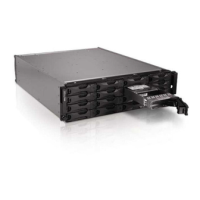Installation and Setup Configuring the Software
3–3
RAID policy RAID level and spare disk drive configuration for the array:
• RAID 10 – Striping on top of multiple RAID 1 (mirrored) sets,
with one or two spare disks. RAID 10 provides good performance
for random writes, in addition to the highest availability.
• RAID 50 – Striping on top of two RAID 5 (distributed-parity)
sets, with one or two spare disks. RAID 50 provides a good
balance of performance (especially for sequential writes),
availability, and capacity. RAID 50 is the only supported RAID
policy for a PS5500 array.
• RAID 5 – One RAID 5 set, with one spare disk. RAID 5 is similar
to RAID 50, with more capacity (two additional disks) but lower
availability and performance.
Table 3-2: Group Configuration
Prompt Description
Group name Unique name that identifies the group (one to 63 letters, numbers, or
hyphens). The first character must be a letter or number.
Group IP address Network address for the group. The group IP address is used for
group administration and computer access to data stored in the group.
Password for
adding members
to a group
Password required when adding members to a group. The password
must have 3 to 16 letters or numbers and is case-sensitive.
Password for the
grpadmin
account
Password that will override the factory-set group administration
password (grpadmin) for the grpadmin account. The password
must have 3 to 16 letters or numbers and is case-sensitive.
Required only when creating a new group.
Microsoft service
user name and
password
(optional)
CHAP user name and password used to enable Microsoft service
(VSS or VDS) access to the group. The user name must have
between 3 and 54 alphanumeric characters. The password must have
12 to 16 alphanumeric characters, and is case-sensitive.
Microsoft services running on a computer must be allowed access to
the group in order to create VSS snapshots in the group or use VDS.
Applicable only when creating a group with the Remote Setup
Wizard.
Table 3-1: Array Configuration (Continued)
Prompt Description

